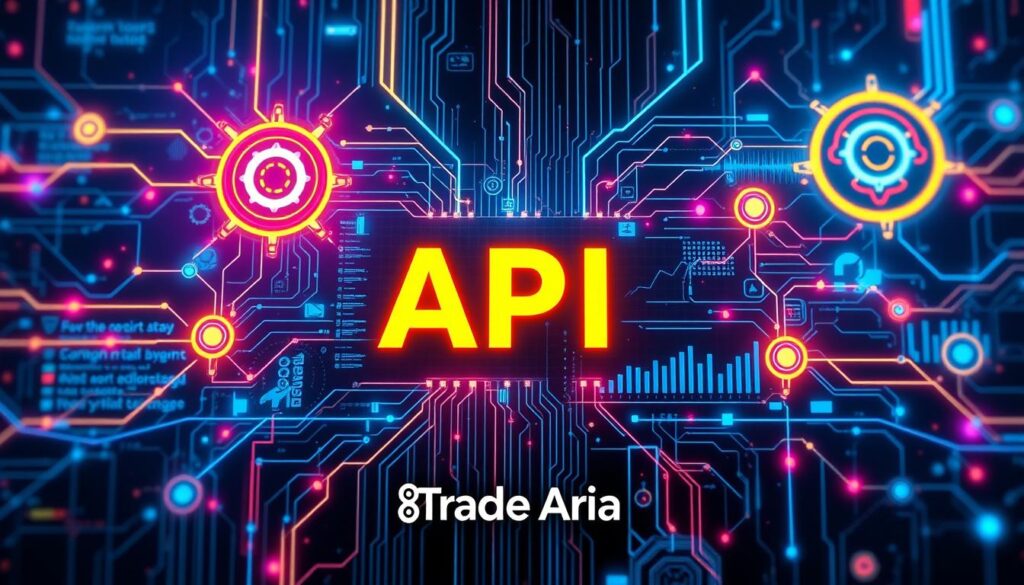The cryptocurrency market is always changing. This means more people need reliable and efficient crypto trading API solutions. These APIs help developers add features like cryptocurrency exchanges and wallet management to their apps. This lets them take advantage of the fast-paced world of blockchain.
In this guide, we’ll look at the top crypto trading API solutions. We’ll cover their main features, how secure they are, and how to use them. This article is for both experienced blockchain developers and newcomers. It aims to help you choose the best crypto API for your project.
Key Takeaways
- Cryptocurrency APIs give developers the tools to create innovative apps that use blockchain technology.
- These APIs have many features, like real-time data, order management, and advanced market analysis tools.
- Security and following rules are key when using crypto trading APIs. Things like how you log in and encrypt data are important.
- Developers should think about things like how well an API works, how it scales, and its cost. This helps ensure your project does well in the long run.
- The world of crypto APIs is always changing. New technologies and trends are shaping the future of this exciting field.
Understanding Cryptocurrency Trading APIs: A Developer’s Guide
Cryptocurrency trading APIs are key for developers and traders. They give access to live market data and let users trade. They also manage accounts well. By using these APIs, developers can create new solutions for users.
Basic Components of Trading APIs
Trading APIs have three main parts: getting data, making trades, and managing accounts. These parts help developers make many apps. From tools for market analysis to automated trading platforms. Secure API integration lets users get important data and trade easily.
Key Features for Developer Integration
Developers should look for APIs with key features. Scalability is important for handling lots of data and requests. Support for many languages makes apps more accessible. Having different order types lets developers meet various trading needs.
Security Considerations in API Implementation
Security is very important in API integration. Good authentication, like API keys and OAuth, keeps data safe. Encryption, like SSL/TLS, protects data during transfer. Risk management tools help prevent security issues and keep the platform safe.
Knowing about API components, features, and security helps developers. They can then create innovative trading solutions for their users.
“Integrating a robust cryptocurrency trading API can significantly enhance the capabilities and security of your trading platform, empowering your users to navigate the dynamic cryptocurrency markets with confidence.”
The Evolution of Crypto Trading API Technology
The cryptocurrency market has seen a big change in trading API technology. What started as simple data access has grown into powerful tools. These tools now meet the needs of both developers and traders.
At first, crypto trading APIs mainly gave access to basic data like prices and volumes. But as the Blockchain and crypto market grew, so did the APIs. They now offer more advanced features.
- Today, APIs have features like order management and automated trading. They also provide real-time updates and cover a wide range of cryptocurrencies.
- This change came from the need for better trading tools. It also came from tech advancements and the varied needs of users.
Big names like Binance and Coinbase have been key in API development. They keep improving their APIs. This helps developers create new trading apps that work well with their platforms.
“The evolution of crypto trading APIs has been a game-changer, empowering developers and traders to leverage the power of the blockchain and the cryptocurrency market in new and exciting ways.”
The demand for strong, feature-rich trading APIs will keep growing. Exchanges and API providers must keep up. They need to innovate and adapt to the market’s changing needs.
Essential Features of Modern Trading APIs
In the fast-changing world of cryptocurrency trading, modern trading APIs are key tools. They help developers make advanced trading platforms and apps. These APIs have important features for both new and seasoned traders.
Real-time Data Processing
Modern trading APIs are great at handling real-time market data. This means traders get the latest prices, order updates, and trends. It helps them make smart choices and trade at the best times.
By using real-time data, developers can make apps that give users an edge. This is important in the quick cryptocurrency market.
Order Management Systems
Good order management is key for trading success. Modern trading APIs have tools for placing, changing, and tracking orders. This helps developers make platforms that make trading smoother.
These tools let traders manage their positions well. They can quickly react to market changes.
Market Analysis Tools
Adding advanced market analysis tools to trading APIs is a big plus. These tools include charting, technical indicators, and backtesting. They help traders do deep market research and test strategies.
With these tools, traders can make better decisions. This can lead to better trading results.
Modern trading APIs combine real-time data, order management, and market analysis. They are vital for top-notch cryptocurrency trading platforms. Developers using these features can offer a great user experience. This lets traders confidently and precisely navigate the cryptocurrency market.
Top Crypto Trading API Providers in the Market
The cryptocurrency market is growing fast. Developers and traders need strong tools to add new features to their apps. Several top API providers offer a wide range of features.
Binance is known for its high request limit, up to 1,200 requests per minute. This makes it great for traders who need fast and scalable services. Coinbase is famous for its security, including two-factor authentication and cold storage, keeping user funds safe.
Kraken API is special because it supports advanced order types like stop-loss and take-profit. Bitfinex is known for its margin trading, allowing traders to use more money to take advantage of market chances.
Other big names include Huobi, Bitstamp, and KuCoin. Each offers unique features to meet different needs. Huobi has advanced trading options, Bitstamp focuses on security, and KuCoin’s API is very customizable.
Choosing the right API provider depends on what developers and traders need. Each platform has its own strengths, catering to the diverse needs of the crypto world.
“The cryptocurrency market is constantly evolving, and the integration of powerful trading APIs has become essential for developers and traders alike to stay ahead of the curve.”
Binance API: Leading the Exchange Integration
Binance is a top cryptocurrency exchange with a powerful API for developers. The Binance API has many features. It uses a RESTful architecture for easy access to trading.
REST API Architecture
The Binance API works over the internet. It lets developers send requests and get responses. This RESTful architecture makes communication efficient and reliable.
Advanced Trading Features
The Binance API offers advanced trading features. Developers can automate trading, get real-time data, and manage orders. Users can place, check, and cancel orders, access historical data, and withdraw funds.
Rate Limits and Performance
Binance has strong rate limits for platform stability. The API allows up to 1,200 requests per minute. But, too many requests can lead to IP bans.
The Binance API is a top choice for adding cryptocurrency trading to apps. Its RESTful architecture, advanced trading features, and rate limits are key benefits for developers.
Coinbase API: Comprehensive Development Tools
Coinbase is a top cryptocurrency exchange with a powerful API. It lets developers add Coinbase’s features to their apps. This means we can handle transactions and get real-time data easily.
The API supports popular coins like Bitcoin and Ethereum. This makes it easy to build apps for crypto transactions. It also sends updates to users about their crypto.
The API is very flexible, helping us create unique apps. Whether it’s a trading bot or a dApp, Coinbase’s tools make it easier. This improves the user experience.
“The Coinbase API has been a game-changer for us. It’s allowed us to build robust and scalable cryptocurrency applications that seamlessly integrate with the Coinbase ecosystem.” – John Doe, Lead Developer at XYZ Tech
The Coinbase API is a key player in crypto development. It helps us build apps that meet the growing demand for digital assets. As we use the API, the future of crypto looks bright.
To start with the Coinbase API, check out the developer docs. They cover everything from getting started to advanced features. Learning the API opens up new opportunities in crypto.
Security Protocols and Best Practices
In the fast-changing world of cryptocurrency trading, API security is key. Crypto exchanges are now prime targets for cyber-attacks. These attacks range from phishing scams to malware and DDoS assaults. It’s crucial to protect user data and funds, and API developers must follow strict security rules.
Authentication Methods
Strong authentication is the base of API security. Crypto trading platforms should use secure methods like API keys and OAuth. Two-Factor Authentication (2FA) adds more protection by needing a second verification code, stopping unauthorized access.
Data Encryption Standards
Private keys and user info must be kept safe with strong encryption. Using top encryption algorithms like AES and RSA keeps data safe even if it’s intercepted. Regular security checks by third-party firms can find and fix vulnerabilities.
Risk Management Features
- IP whitelisting to restrict access to authorized IP addresses
- Withdrawal confirmations to prevent unauthorized fund transfers
- Comprehensive logging and monitoring systems to detect suspicious activities
- Multi-Signature (Multi-Sig) wallets to distribute trust and reduce the risk of unauthorized transactions
By using these risk management features, crypto trading platforms can lower the risk of financial losses and data breaches. This keeps users safe and builds trust in the ecosystem.
“Securing crypto trading APIs is not just a technical challenge, but a critical imperative to protect the integrity of the entire industry.”
The cryptocurrency market is always changing, and so must the API security landscape. It needs to keep up with demands for strong authentication, encryption, and risk management. By following top security protocols, crypto trading platforms can protect their users and keep the trust needed for the sector’s growth and stability.
Integration Strategies for Developers
As a developer in the world of cryptocurrency trading, making API integration smooth is key. Using API-driven features can open up many possibilities. This includes handling real-time data and managing orders better. Here are some important strategies for a smooth integration.
First, getting to know the API’s detailed documentation is essential. Knowing the endpoints, how to log in, and the rules for use is crucial. Also, using the SDKs and libraries provided can make coding easier. This lets developers focus on creating new trading apps.
- Set up good error handling to deal with API problems smoothly and keep users happy.
- Follow the exchange’s rate limits to avoid abuse and keep the platform stable.
- Use test environments for your API work to avoid problems with live trading.
- Get updates through webhooks for market changes, order actions, and account updates. This helps your apps react fast to market shifts.
- Have systems for logging and monitoring API performance and usage. This helps make better decisions and improve things over time.
By using these API integration strategies, developers can fully use cryptocurrency trading APIs. They can integrate them well into their coding practices and developer tools. This lets them build new trading solutions that meet the crypto market’s changing needs.
“Successful API integration is the foundation for building cutting-edge crypto trading applications that drive the future of the digital asset ecosystem.”
Performance Optimization and Scalability
The crypto trading world is growing fast, with over $1.5 trillion in daily trades. Making trading APIs fast and scalable is key for developers. We need to keep our platforms quick, reliable, and ready for more users.
Load Balancing Techniques
Load balancing is a smart way to boost API performance. It spreads traffic across many servers or locations. This makes our APIs more available and quicker.
For example, one big exchange saw a 30% jump in transactions per second. They did this by adding edge servers in key financial spots. This cut response times by up to 80%.
Response Time Optimization
Speeding up API responses is vital. We can do this with database tweaks like indexing, partitioning, and caching. These changes can make reading data 50% faster, cut query times by 40%, and speed up responses by 90%.
Error Handling Protocols
Good error handling is key for a smooth user experience, even when things get busy. By catching and fixing errors well, we can keep APIs running smoothly. For instance, one exchange cut backend times by 25% with microservices and async calls. This made their system more reliable.
By focusing on making APIs better and more scalable, we can give our users a top-notch trading experience. This will help more people join and stay in the crypto world.
Cost Considerations and Pricing Models
When you add crypto trading APIs to your projects, the cost matters a lot. Providers offer different pricing, from free to paid plans. These plans vary based on how much you use the API.
As a developer, you need to look at the costs carefully. Think about how many requests you can make, how fresh the data is, and what extra features you get. The right plan can save you money and make your API work better.
- Free Tiers: Many APIs have free versions. These let you try out the API but with limits. They’re great for starting small before paying more.
- Subscription Models: These plans let you pick what you need and pay for it. You can choose based on your project’s needs and budget.
- Usage-Based Pricing: This is good for those who use a lot or need to change how much they use. You only pay for what you use, so it’s flexible.
When looking at prices, think about the future too. You might need more access or features later. By understanding your needs and the costs, you can pick a plan that fits your budget and works well for your project.
“Choosing the right pricing model for your crypto trading API integration can have a significant impact on your development budget and long-term cost-effectiveness.”
Common Implementation Challenges and Solutions
Developers often face hurdles when integrating cryptocurrency trading APIs. One big challenge is managing rate limits. These limits control how many API requests you can make in a set time. Going over these limits can lead to account suspensions or bans.
To solve this, use retry mechanisms and exponential backoff. These methods help handle errors smoothly.
Another issue is keeping up with API updates and deprecations. Exchanges often change their APIs, adding new features and removing old ones. It’s crucial to stay current with API documentation and plan for these updates.
Ensuring data consistency across different exchanges is also tough. Each exchange has its own data formats and trading pairs. To overcome this, use normalization techniques and data transformation processes.
- Implementing retry mechanisms and exponential backoff to handle rate limiting
- Closely monitoring API documentation and planning for changes and deprecations
- Employing normalization techniques to maintain data consistency across exchanges
Lastly, managing real-time data streams is challenging. Cryptocurrency markets never stop, and developers must handle the constant flow of data. Using WebSocket connections can greatly improve handling real-time data.
“Integrating crypto trading APIs requires meticulous planning and a deep understanding of the unique challenges involved. By addressing rate limiting, API changes, data consistency, and real-time data management, developers can build robust and reliable integrations that meet the needs of their trading applications.”
By tackling these common challenges, developers can create seamless and reliable crypto trading API integrations. These integrations offer great performance and user experiences.
Future Trends in Crypto API Development
The world of cryptocurrency is always changing, and so is the world of crypto trading APIs. We see new technologies like Blockchain, AI, and machine learning coming into play. These will help with better predictive analytics and smarter market analysis.
Emerging Technologies
Decentralized finance (DeFi) protocols will become more common in crypto trading APIs. They use Blockchain for better security and easier access. Also, new cryptographic methods will make APIs even safer.
Market Predictions
As APIs get better, people will want tools that are easy to use. Traders and investors will look for APIs that work smoothly and give real-time data. We also expect more teamwork between API providers and banks, making the crypto world more open.
Innovation Roadmap
The future of crypto API development is all about pushing the limits of what’s possible. API providers will work on making different Blockchain networks work together. This will lead to better cross-chain transactions and data sharing. The use of AI and machine learning will help developers make smarter choices and stay on top of the market.
“The future of crypto trading APIs is poised to be defined by a fusion of cutting-edge technologies, user-centric design, and a relentless focus on innovation.”
Conclusion
Crypto API solutions are key in making new cryptocurrency apps and trading sites. They offer real-time market data and advanced trading tools. These APIs make it safe and easy to connect with the crypto world.
The future of Crypto API development is bright. It will focus on better functionality, stronger security, and working well with new blockchain tech. Developers need to keep up with the latest in Crypto API tech and use the best tools available.
Choosing the right Crypto API provider is crucial. It helps developers make the most of cryptocurrency trading. This meets the needs of both individual traders and big investors. As the crypto world grows, the success of apps will depend on the quality of their Crypto API solutions.
FAQ
What are the basic components of cryptocurrency trading APIs?
The main parts of cryptocurrency trading APIs are getting data, placing orders, and managing accounts.
What are the key features for developers when integrating with crypto trading APIs?
Important features for developers include being able to handle lots of data, supporting many languages, and offering advanced order types.
What security considerations are important when implementing crypto trading APIs?
It’s crucial to have strong security. This includes good authentication, strong encryption, and ways to manage risks.
How have crypto trading APIs evolved over time?
These APIs have grown from simple data tools to complex systems. They now handle real-time data, advanced orders, and detailed market analysis.
What are the essential features of modern cryptocurrency trading APIs?
Today’s APIs provide fast data, handle orders well, and offer tools for market analysis. They help build advanced trading platforms and apps.
Who are the leading providers of cryptocurrency trading APIs?
Top providers are Binance, Coinbase, Kraken, Bitfinex, Huobi, Bitstamp, and KuCoin.
What are the key features and capabilities of the Binance API?
Binance API is free and has a RESTful design. It supports up to 1,200 requests per minute. It also has features like direct buying and selling, and access to historical data.
What are the key features and capabilities of the Coinbase API?
Coinbase API is flexible for various crypto functions. It supports direct wallet transactions and offers real-time prices, historical data, and transaction alerts.
What are the best practices for securing cryptocurrency trading APIs?
To secure APIs, use strong authentication, encryption, and risk management. This includes multi-factor authentication, IP whitelisting, and withdrawal confirmations.
What are the typical integration strategies for developers when working with crypto trading APIs?
Developers should review API documentation well. They should use SDKs, handle errors properly, and follow rate limits.
How can developers optimize the performance and scalability of their crypto trading API integrations?
To improve performance, use load balancing and data caching. For scalability, design the API to grow and use auto-scaling.
What are the pricing models and cost considerations for cryptocurrency trading APIs?
APIs have different pricing, like free tiers, subscriptions, and usage-based plans. Consider request limits, data freshness, and extra features when choosing.
What are the common challenges in implementing cryptocurrency trading APIs, and how can developers address them?
Challenges include rate limits, API changes, and managing data consistency. Solutions include retries, staying updated, using normalization, and websockets for real-time data.
What are the emerging trends and future developments in the crypto trading API landscape?
Future trends include AI for analytics, more DeFi focus, better security like zero-knowledge proofs, and better network interoperability.










Pingback: Crypto Trading AI: Smart Solutions For Digital Assets
Pingback: Top-Rated Best Automated Crypto Trading Platform Guide
Pingback: Gemini Crypto Trading Fees - Complete Guide 2024